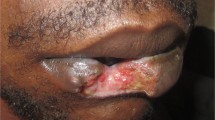Abstract
Introduction
Bite wounds of the oral mucosa heal after eliminating the causative irritant, but there are serious exceptions from the rule. We present the case of a 37-year-old woman with an ulcer of the mucosa of the lower lip, which had been present for 10 days, and leucopenia.
Discussion
Agranulocytosis after the use of metamizole is part from leukaemia and lues, a rare reason for non-healing ulcers of the mucosa of the oral cavity without fulminant signs for inflammation.
Conclusion
As this is a life-threatening disease, medical therapy must begin immediately.

Similar content being viewed by others
References
The International Study of Agranulocytosis and Aplastic Anemia (1986) Risks of agranulocytosis and aplastic anemia. A first report of their relation to drug use with special reference to analgesics. The international agranulocytosis and aplastic anemia study. JAMA 256:1749–1757
Edwards JE, McQuay HJ (2002) Dipyrone and agranulocytosis: what is the risk? Lancet 360:1438
Hamerschlak N, Cavalcanti AB (2005) Neutropenia, agranulocytosis and dipyrone. Sao Paulo Med J 123:247–249
Hedenmalm K, Spigset O (2002) Agranulocytosis and other blood dyscrasias associated with dipyrone (metamizole). Eur J Clin Pharmacol 58:265–274
Ibanez L, Vidal X, Ballarin E, Laporte JR (2005) Agranulocytosis associated with dipyrone (metamizol). Eur J Clin Pharmacol 60:821–829
Levy M, Shapiro S (1986) Safety of dipyrone. Lancet 2:1033–1034
Musher DM (1987) Syphilis. Infect Dis Clin North Am 1:83–95
Ohishi M, Oobu K, Miyanoshita Y, Yamaguchi K (1988) Acute gingival necrosis caused by drug-induced agranulocytosis. Oral Surg Oral Med Oral Pathol 66:194–196
Schonhofer P, Offerhaus L, Herxheimer A (2003) Dipyrone and agranulocytosis: what is the risk? Lancet 361:968–969
Singh AE, Romanowski B (1999) Syphilis: review with emphasis on clinical, epidemiologic, and some biologic features. Clin Microbiol Rev 12:187–209
Vlahov V, Bacracheva N (1989) Agranulocytosis and dipyrone. Lancet 2:1215
Warnke PH, Sherry E, Russo PA, Acil Y, Wiltfang J, Sivananthan S, Sprengel M, Roldan JC, Schubert S, Bredee JP, Springer IN (2006) Antibacterial essential oils in malodorous cancer patients: clinical observations in 30 patients. Phytomedicine 13:463–467
Author information
Authors and Affiliations
Corresponding author
Rights and permissions
About this article
Cite this article
Becker, S.T., Wiltfang, J., Springer, I.N. et al. Life-threatening bite injury of the lower lip after use of metamizole. Oral Maxillofac Surg 12, 39–41 (2008). https://doi.org/10.1007/s10006-008-0099-3
Published:
Issue Date:
DOI: https://doi.org/10.1007/s10006-008-0099-3




